Advertisements
Advertisements
प्रश्न
Suppose you have three resistors, each of value 30 Ω. List all the different resistances you can obtain using them.
उत्तर
(a) When the three resistors are connected in series:-

The resultant resistance, Req = R + R + R = 90 Ω
(b) When the three resistors are connected in parallel:-
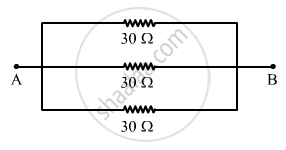
The resultant resistance of the combination,
\[\frac{1}{R_{eq}} = \frac{1}{R} + \frac{1}{R} + \frac{1}{R} = \frac{3}{R} = \frac{3}{30} = \frac{1}{10}\]
\[\Rightarrow R_{eq} = 10\Omega\]
(c) When two of the resistors are connected in parallel and this combination is connected in series with the third resistor:-
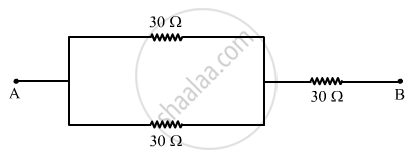
Let R' be the resultant resistance of the two resistors connected in parallel to each other. Therefore,
\[\frac{1}{R'} = \frac{1}{R} + \frac{1}{R} = \frac{2}{R} = \frac{2}{30} = \frac{1}{15}\]
\[\Rightarrow R' = 15 \Omega\]
Now, the net resistance of the combination of the resistors,
Req = R' + R = 15 + 30 = 45 Ω
(d) When two of the resistors are connected in series and the combination is connected to the third resistor in parallel:-

Let R' be the resultant resistance of the series in combination. Therefore,
R' = R + R = 30 + 30 = 60 Ω
Now, let the net resultant of the combination be Req. So,
\[\frac{1}{R_{eq}} = \frac{1}{R'} + \frac{1}{R} = \frac{1}{60} + \frac{1}{30} = \frac{3}{60} = \frac{1}{20}\]
\[\Rightarrow R_{eq} = 20 \Omega\]
APPEARS IN
संबंधित प्रश्न
If the combination is connected to a battery of emf 12 V and negligible internal resistance, obtain the potential drop across each resistor.
Find the equivalent resistance of the circuits shown in the figure between the points a and b. Each resistor has resistance r.
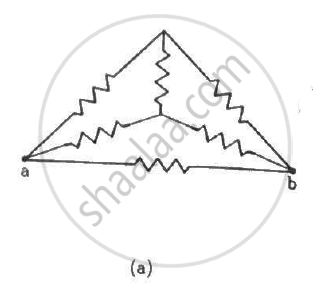

Find the current measured by the ammeter in the circuit shown in the figure.
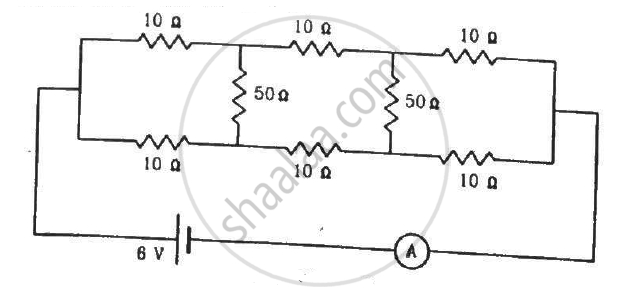
The voltmeter shown in the figure reads 18 V across the 50 Ω resistor. Find the resistance of the voltmeter.

Two resistors R1= 60 Ω and R2 = 90Ω are connected in parallel. If electric power consumed by the resistor R1 is15 W, calculate the power consumed by the resistor R2.
In a meter bridge circuit, resistance in the left-hand gap is 2 Ω and an unknown resistance X is in the right-hand gap as shown in the figure below. The null point is found to be 40 cm from the left end of the Wire. What resistance should be connected to X so that the new null point is 50 cm from the left end of the wire?
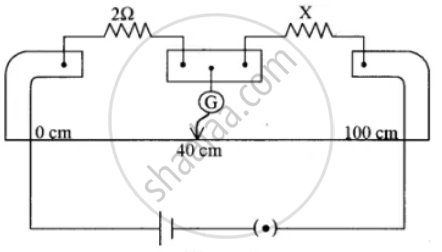
A solenoid L and a resistor R are connected in series to a battery, through a switch. When the switch is put on, current I flowing through it varies with time t as shown in which of the graphs given below:
If the combination is connected to a battery of emf 20 V and negligible internal resistance, determine the current through each resistor, and the total current drawn from the battery.
An ammeter together with an unknown resistance in series is connected across two identical batteries each of emf 1.5 V. When the batteries are connected in series, the galvanometer records a current of 1A and when the batteries are in parallel, the current is 0.6A. Then the internal resistance of the battery is ______.
To get maximum current in a resistance of 3 ohms, one can use n rows of m cells (connected in series) connected in parallel. If the total number of cells is 24 and the internal resistance of a cell is 0.5 ohms then ______.
Combine three resistors 5 Q, 4.5 Q and 3 Q in such a way that the total resistance of this combination is maximum ______.
In parallel combination of n cells, we obtain ______.
The figure shows three conductors I, II and III of same material, different lengths l, 2l and 3l and of different areas of cross-sections 3A, A and 2A respectively. Arrange them in the increasing order of current drawn from the battery.
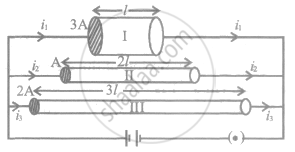
The effective resistance of a parallel connection that consists of four wires of equal length, equal area of cross-section and the same material is 0.25 Ω. What will be the effective resistance if they are connected in series?
The effective resistance of a parallel connection that consists of four wires of equal length, equal area of cross-section and same material is 0.25 Ω. What will be the effective resistance if they are connected in series?
Eight identical cells, each of emf 2V and internal resistance 3 Ω, are connected in series to form a row. Six such rows are connected in parallel to form a battery. This battery is now connected to an external resistor R of resistance 6 Ω. Calculate:
- emf of the battery.
- internal resistance of the battery.
- current flowing through R.
Three bulbs B1 (230V, 40W), B2 (230V, 60W) and B3 (230V, 100W) are connected in series to a 230V supply. Which bulb glows the brightest?
